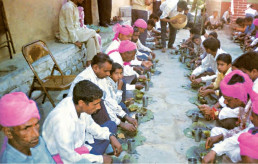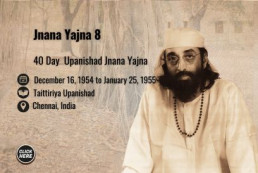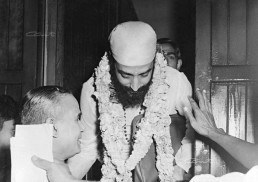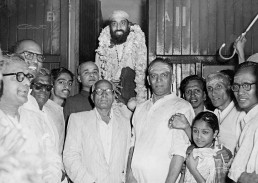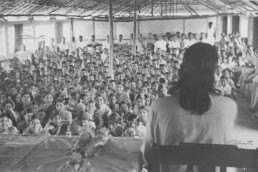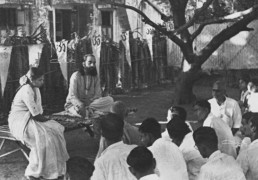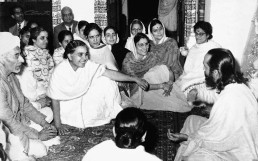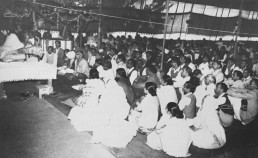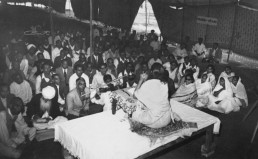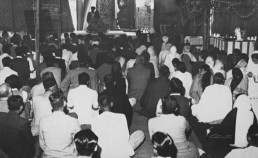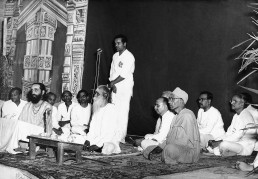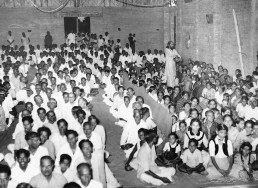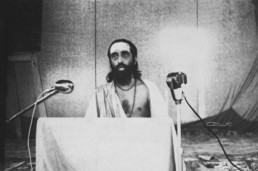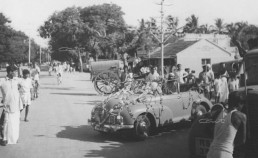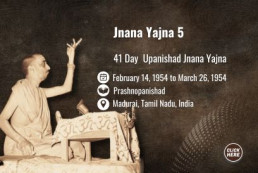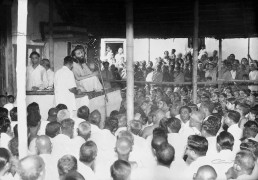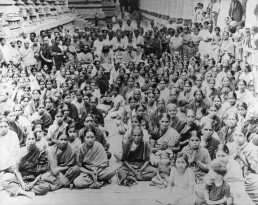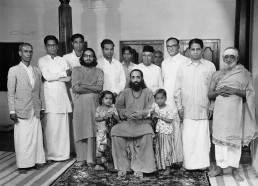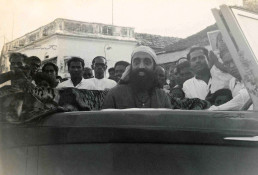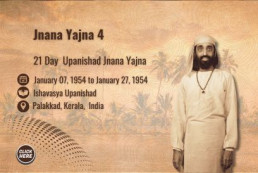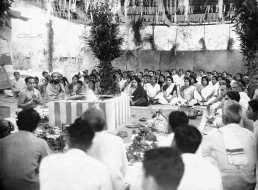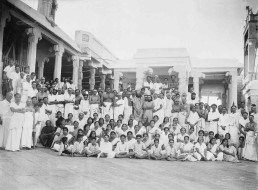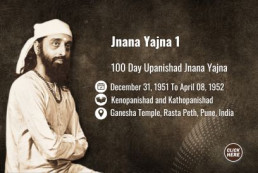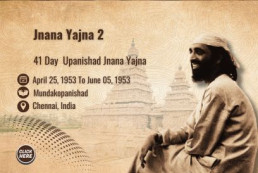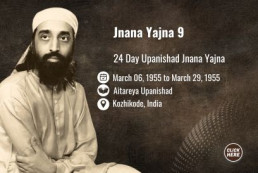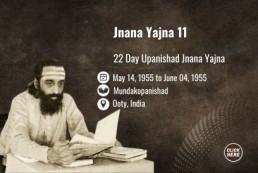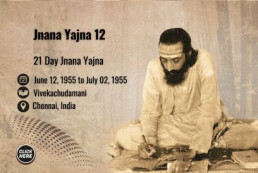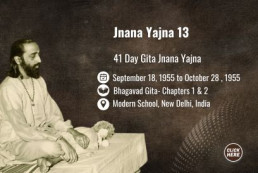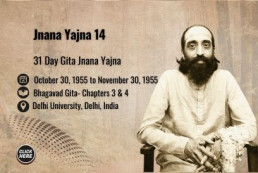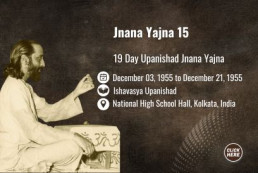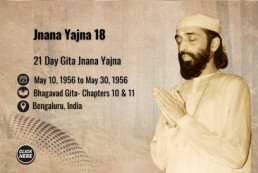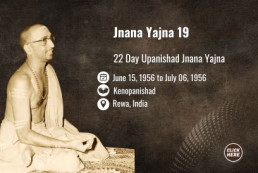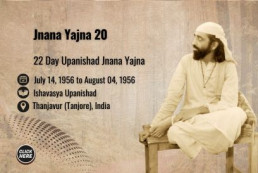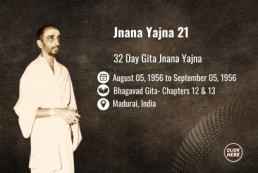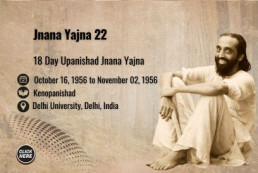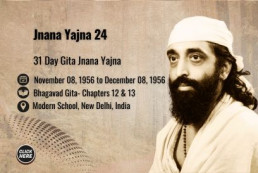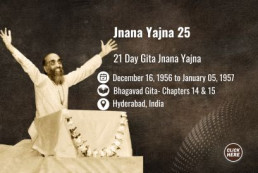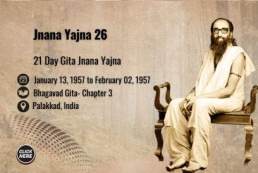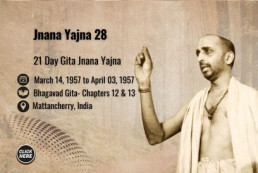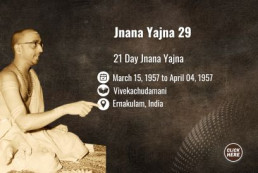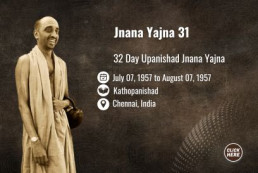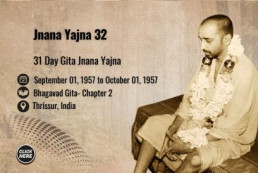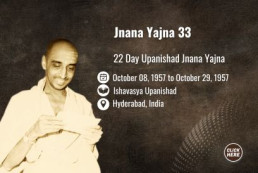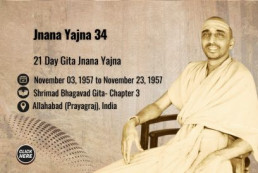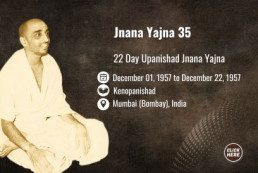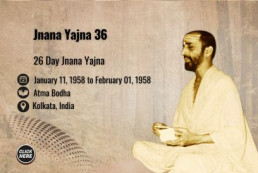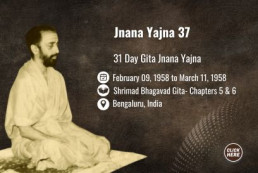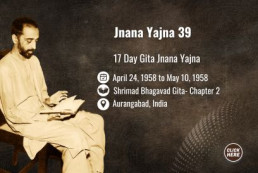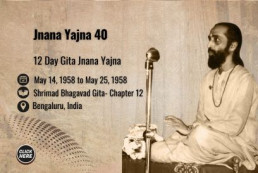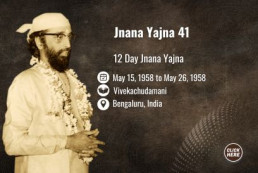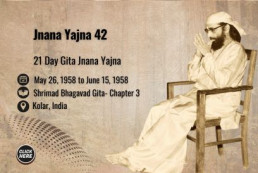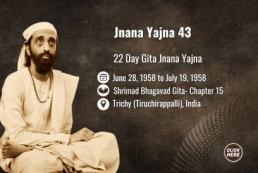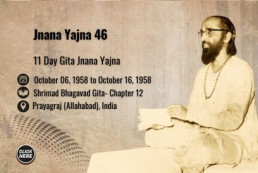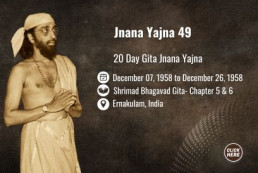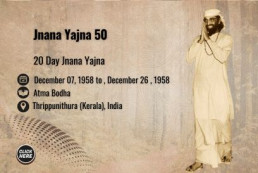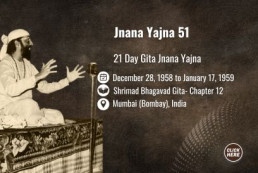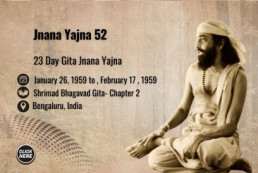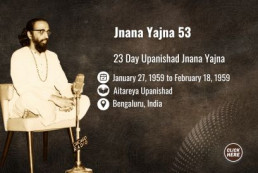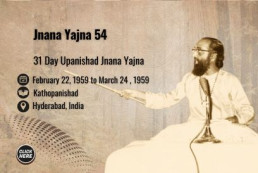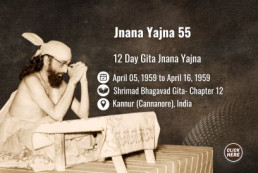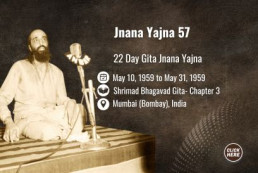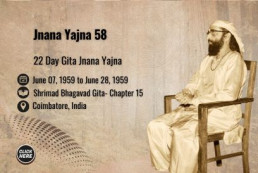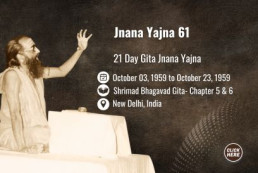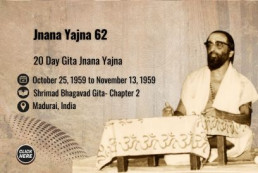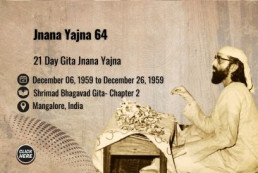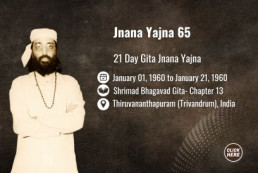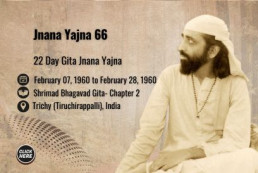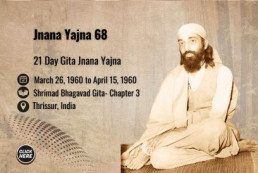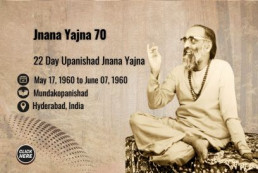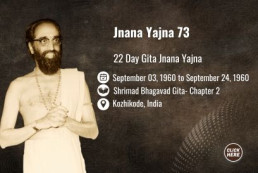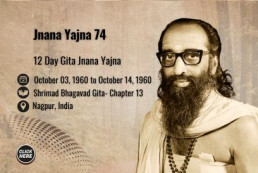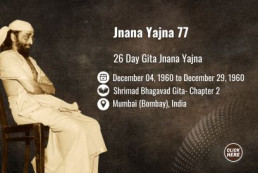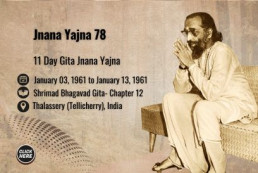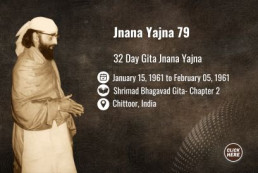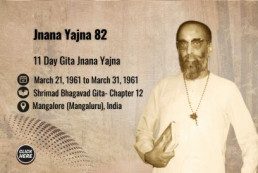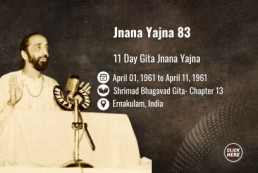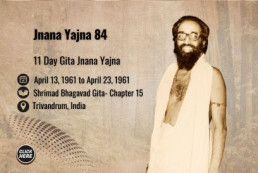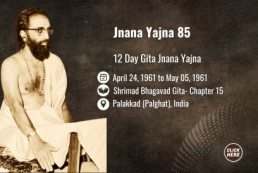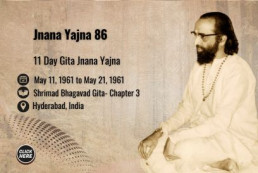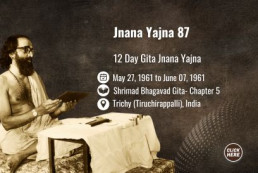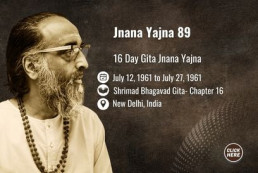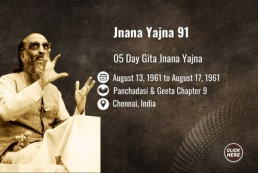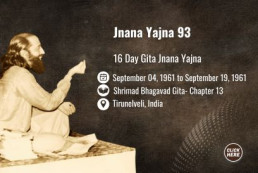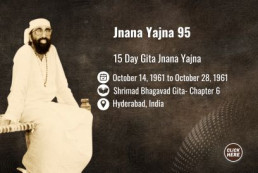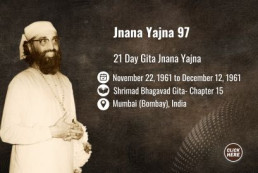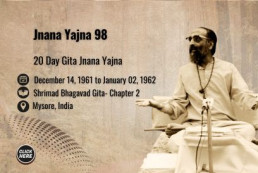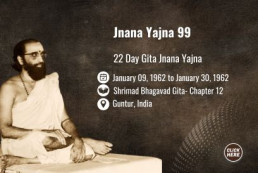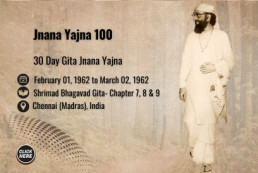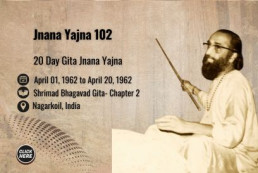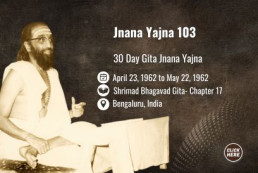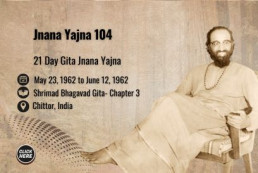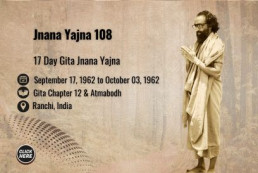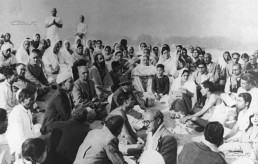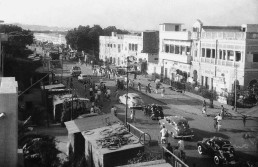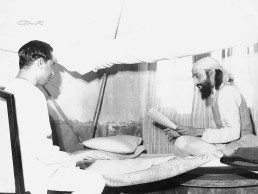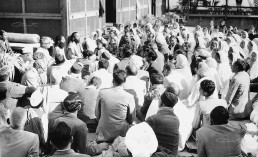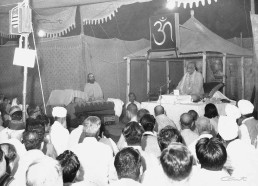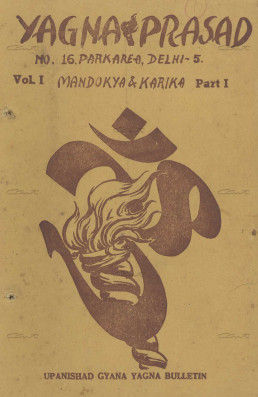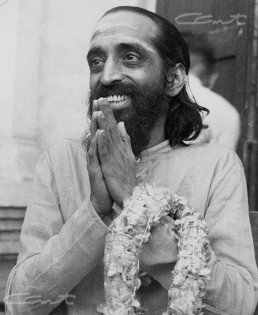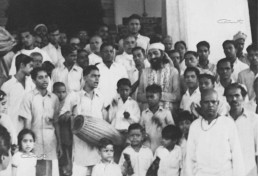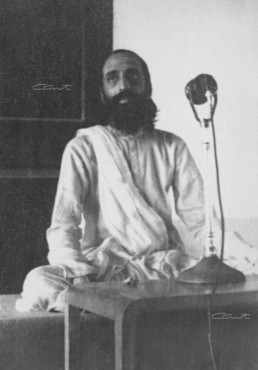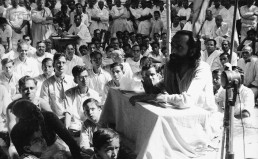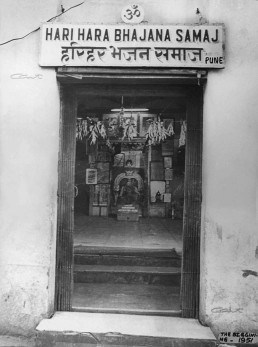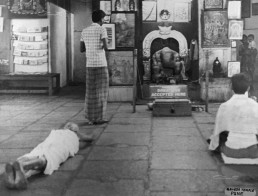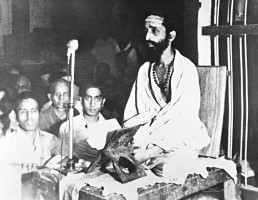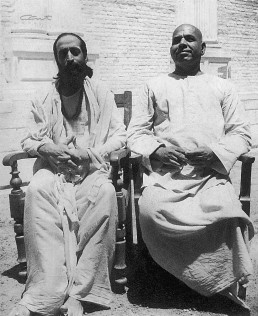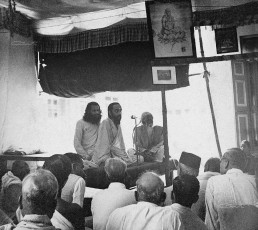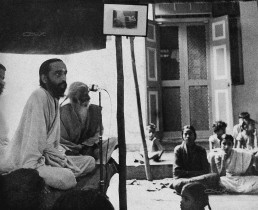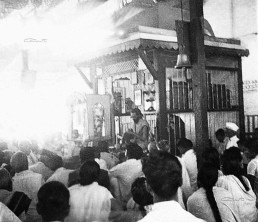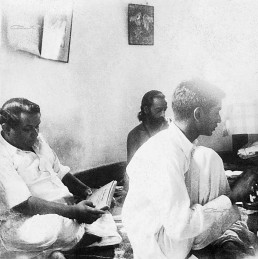Jnana Yajna 8
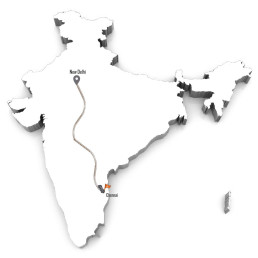
Jnana Yajna 8

Year & Dates:
December 16, 1954 to January 25, 1955

Yajna Topics:
Taittiriya Upanishad

Place:
Chennai, India.
It was an exhilarating, energetic unfoldment for 41 days in Thyagarayanagar, Chennai (Madras). The huge Pandal (enclosure) could not hold the teeming crowds; more than a thousand of the nearly 4000 people would stand for close to two hours engrossed in the inexpressible bliss of the melodic Taittiriya Upanishad. As Pujya Gurudev Swami Chinmayananda explained about the different kinds of Upasana in the first section of the Upanishad, the listeners were inspired. He also highlighted the ancient, convocation address of 25 key instructions given to students in Section 11 of Shikshavalli, pointing out that they were “Vedanta in Practice.” Those sacred commandments began with the teacher’s reminder, “Satyam Vada ” and pointed to how one can live a noble, integrated life.
Deeper Study, Increasing Crowds
Having prepared the audience to lift themselves to a higher vision of life, Pujya Gurudev guided them into the sublime, direct definition of Truth as “Satyam, Jnanam, Anantam.” Sharing the depth of the second section, “Brahmananda Valli,” He also challenged seekers to journey within and enquire intensely. Pujya Gurudev’s systematic, scientific analysis of the five sheaths (Panchakosa) within the human personality was gripping. The way He described the ascending scale of joy in the evolution toward the Absolute amazed the audience. The immortal discussion between Varuna, the Teacher, and Bhrigu, the Disciple outlining the steps to enquire and realize the Highest goal of life was embedded in the minds of the attentive audience. The thirst to realize that “The Source of all joy in the entire universe is but the Bliss of the Self ” was created in that momentous yajna. The earnest seekers who had already begun devoted study of the Upanishads after Pujya Gurudev’s second yajna in Chennai were further motivated to learn, analyze, and apply the scriptural teachings. The phenomenon called Chinmaya Study Groups would soon spread around the country and later the world.
In Admiration
Smt. Meenambal of Chennai vividly captures the transformative voyage guided by Pujya Gurudev Swamiji Chinmayananda, steering her weather-beaten vessel through life’s stormy ocean. “At first it was his learned exposition couched in the finest poetry that drew me to him. The fatigue of the day’s work or the distance that had to be walked or the rains could not stop me. I was drawn by some irresistible force, as it were. I felt I has at last landed on a sequestered harbour. What the temples, the Bhajans and the discourses failed to give me, the lucid explanations of the Upanishad by Chinmaya gave me. The mysteries of the grand universe, of which this little “I” forms a part, were slowly unravelled by my Guru, who, by his inimitable examples, made easy the most un-understandable portions of our Hindu philosophy.”
Photo Gallery
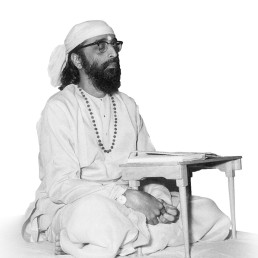
“Think,” Says Pujya Gurudev
All Upanishads start with a ‘peace invocation’, a prayer to the Cosmic Powers to ward off all obstacles on the path of study, and this prayer id daily chanted together by the teacher and the taught. A prayer is an invocation, and not a contract. Now-a-days, we are misusing this technique of prayer in our own ignorance and therefore we find that our Gods are deaf to our prayers. This is true today with all religions. The science of prayer explains, that when an individual surrenders himself-meaning, all his identifications with his body, mind and intellect-through devotion, reverence and understanding-love, he removes from himself all the causes for his limitations and what is thus left over is the Absolute perfection which is the essence of his very being. Thus, prayer is the active part of the divine action, while the final successful invocation is its fulfilment.
Taittiriya Upanishad Book, p. 8
In the definition of this bliss the scripture also gives us indirectly the conditions necessary for true material enjoyment. Wealth in itself is no joy unless the rich man is young enough. Mere youthfulness dissipates itself in wealth unless he is well-educated to live the healthy values of life. Mere knowledge and youthfulness cannot contribute to the enjoyment of the wealth unless he is well-disciplined and has developed sufficiently his willpower. One who has youthfulness, education, discipline, and power of self-control and self-assertion, if he is strong in body, mind and intellect, he alone is capable of enjoying wealth. To all others wealth is an added burden weighing down their shoulders. A donkey carrying golden bricks is in no way better and luckier than the donkey which is carrying mudbricks! The Prarabdha of the pigs cannot be improved because they are housed in Prime Minister’s own drawing-room.
Taittiriya Upanishad Vol. 1, No. 4 Yajna Prasad, p. 168
Curious About Fearless Wisdom?
Beyond ordinary joy lies the profound experience of Ananda Brahman. In this enlightening discourse from Taittiriya Upanishad, witness how the Vidvan, the true knower, conquers fears and transcends regrets, unveiling a life of eternal bliss. Dive into the culmination of the Upanishad with us, exploring the timeless wisdom that leads to self-realization. The excerpt presented here is an audio except from Taiittiriya Upanishad discourses given in Chennai, 1963.
Jnana Yajna 7
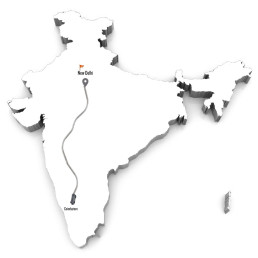
Jnana Yajna 7

Year & Dates:
September 26, 1954 to November 26, 1954

Yajna Topics:
Kathopanishad

Place:
New Delhi, India.
A warm welcome in New Delhi signaled a happy start to Pujya Gurudev Swami Chinmayananda’s seventh Jnana Yajna. The pace during the 61-day discourse series was brisk. Keeping with His unique style of introducing the main Upanishad with a series of preliminary talks, Pujya Gurudev spoke about the “Scientists of Life,” the rishis who studied and analyzed life exhaustively. Particularly in that age of reason over tradition, His preliminary talks gathered the attention of all who went from being simply curious to very committed. His evening discourses on Kathopanishad brought to life the thought-provoking discussion between the young seeker Nachiketa and the God of Death, Dharmaraja, inspiring not just Hindus but also people of varied faiths.
From Preliminary to Profound
It was during the 7th yajna that All India Radio recorded His talks on Religion & Life, Taming the Mind, and Mental Rehabilitation. Pujya Gurudev also taught Vivekachoodamani, Adi Shankara’s great text, during the morning 6:30 to 8:30 am discourses; the book manuscript of His famous commentary was close to being published. The Akanda Kirtan from October 26 to Nov.14, 1954, the Mrtyunjaya Havana from November 9 -14 with an hour’s chanting of the Tryambaka mantra from 8-9 am, and a six day Japa from November 15 – all these infused strength and enthusiasm in hundreds of people. On November 27th, after the Kathopanishad yajna concluded, Pujya Gurudev was invited to bhiksha at the President of India’s Rashtrapati Bhavan. Completing an immersion ceremony of the sacred ashes from the Havana Kund in the waters of Ganga, Haridwar, Pujya Gurudev marched southward, promising Delhi that more would come!
In Admiration
Mobasser, a Jew, while exploring Indian culture and Hinduism, found it initially confusing. He observed a Swami’s English discourses on Kathopanishad happening in Parliament Street, and soon found the jig-saw puzzle of Hinduism come together. He says “Swamiji gave me what I was seeking all round the globe. His universality charmed me; his scientific approach held me spell-bound; his grasp of details filled my hunger to know Hinduism. I discovered in Vedanta the Spirit of Persia. My own Persian Literature became a live-philosophy to me!”
Another devotee Susheela Sharma who considers herself fortunate to have attended the Kathopanishad discourses reminisces, “Gurudev was like the hawker, with utmost patience, brought out mysteries from the basket of KATHA that each evening was an event more thrilling than the movies! It did me good; I got what I wanted right at my doors.
If not for the “Door Delivery”, I would have been completely ignorant of my own Religion like thousands of others. Thank you Swamiji!
Photo Gallery

“Think,” Says Pujya Gurudev
This spirit of sacrifice and capacity to find within oneself enough sympathy to serve not only one’s own near and dear relatives but also the whole universe and thus put their Kalyan first, even before one’s own redemption, is one of the most important qualifications unavoidable in a true seeker, if he is to be a total success in his pilgrimage to Truth.
Kathopanishad Vol.1, part 2 p.55
“creation is a motion, a vibration of energy” and that it is possible for the vibration to maintain itself only if there be a motionless and nonvibrating medium, the Absolute Reality. Constant change can certainly give us the delusion of a form ; only there must be a constant medium, for the changes to play in or at least a constant axis upon which they can play. Thus, when a lit up Joss-stick (aggarbati) is rotated fast round the same axis we can detect the joss-stick maintaining itself in the form of a golden circle. The golden circle has no existence except in the consistency of change at the brilliant tip. Similarly, constant vibration of energy in a medium of Absolute Energy, and maintaining itself within the field of a constant axis gives us that ocean of sense objects made up of things and beings.
Kathopanishad Vol.1, part 6 p. 349
Sacred Duties of a Spiritual Seeker
Delve into the spiritual trinity of duties – scripture study, charitable actions, and knowledge-sharing – as we explore the holistic path of a spiritual aspirant. Uncover the profound impact of these duties on spiritual unfoldment, transcending material desires. Watch this striking snippet from Kathopanishad talk series by Pujya Gurudev Swami Chinmayananda given in Toronto, Canada in 1982.
Jnana Yajna 6

Jnana Yajna 6

Year & Dates:
May 9, 1954 to May 30, 1954

Yajna Topic:
Kenopanishad

Place:
Coimbatore, India.
Pujya Gurudev Swami Chinmayananda’s skilful use of English, a foreign language, to unravel the glory of the ancient Vedic scriptures was his singular contribution. An important colonial legacy that the British left behind was redefined as a unifying medium of a Vedantic awakening across India. Using his command of English to clarify and instill the essence of the ancient Upanishadic revelations from the very first yajna, Pujya Gurudev spearheaded a remarkable revolution.
As in the previous five yajnas, Pujya Gurudev Swami Chinmayananda did not hesitate to reach out and draw in the English-educated doubters as well as eager seekers to His 21-day discourse series on Kenopanishad in Coimbatore.
English for Enlightenment
Those who, with an anglicized outlook, had thought that the scriptures were irrelevant and incomprehensible were fascinated with Pujya Gurudev’s mastery over both the language and the subject of Vedanta. The audience did not need to know Sanskrit. Every word in Sanskrit was transliterated, translated, and explained in clear English from his very first yajna in Pune. Often, Pujya Gurudev’s expressions were poetic and painted a graphic picture. While indicating how the Infinite Brahman is inexplicable, Pujya Gurudev said: “We cannot produce the war of rolling thunders through the frail melodies of a flute!! Similarly, words cannot represent or express fully the roaring silence of all-full-nothingness, Pure Consciousness. In their attempts at reaching the Absolute, words pant and fall back as it were!” Throughout the Kenopanishad discourses in Coimbatore, while the vast audience marveled at Pujya Gurudev’s proficiency in English, they also recognized how His teaching went beyond the realm of language.
In Admiration
Recalling the profound influence of the discourses in Coimbatore, Shri R Venkataswamy Naidu of Coimbatore expresses how they served as nourishment for the intellect of all. “For me it was love at first sight. There was a void before and the lectures filled up the void. The scientific nature of our religion was pointed out and Chinmaya showed how the other religions cannot stand the test of modern scientific research. Hinduism, the revered old channel, sans eyes and sans teeth and sans everything, was presented to us as a young maiden of sixteen, smiling, dancing and full of life.”
Photo Gallery

“Think,” Says Pujya Gurudev
Mere book knowledge will not help in fulfilling the Indian philosophy. Unlike the philosophies of the West, to us the Indians a mere academic understanding of an intellectual view of life is not philosophy. To the Indian mind philosophy is at once a view of life and a way of life. A philosopher to us is not a mere idle-dreamer or an intellect-spinner but a hard and factual man of life who should show us also a certain value of life and how best his philosophy can be lived and realised. It is very significant in this connection to note that the word philosophy is in Sanskrit termed as “Darshanam” emphasis being in the availability of those ideas for realisation in the given life.
From Kenopanishad Yajna Prasad, p. 170
The student feels confused and confounded, Thus, to solve this Great Grand Riddle of Life, he approaches his Guru enquiring if there is an independent Eternal “director” who, by his mere “Wish” prompts the mind to alight on the objects? If there be such a a great Illuminator and Controller who is he? What is it? What is my relationship with the Supreme power Divine existing ever so secretively within me, ever vigilant, ever brilliant, ever alert?
It is now the function of the Upanishad to point out this realizable Truth that there is such a Divine Spark in us, which is Eternal Wisdom, the Atman.
From Kenopanishad Yajna Prasad, p. 94
Questioning the Unquestionable
Dive into the mysteries of scriptural texts as we unravel the contemplative style that seeks to express the inexpressible. Discover the efficiency and beauty embedded in the sacred scriptures of the world. Watch this powerful snippet from Kenopanishad talks given at Houston, TX, USA in 1981.
Jnana Yajna 5
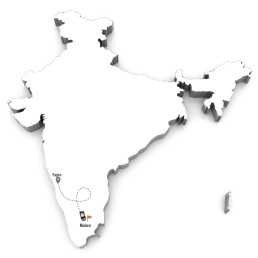
Jnana Yajna 5

Year & Dates:
February 14, 1954 to March 26, 1954

Yajna Topic:
Prashnopanishad

Place:
Madurai, India.
In the sacred town of Goddess Meenakshi and Lord Sundareshwara, Pujya Gurudev Swami Chinmayananda expounded on Prashnopanishad every evening during his 41-day, fifth Jnana Yagna. His discourses painted a striking picture of the six advanced disciples approaching Sage Pippalaada with their philosophical questions about creation, worship, sadhana, the realms of dream and deep sleep, and the seat of the Eternal Self. However, His eloquence was not just with His words. Ending every session with twenty minutes of meditation, His teaching of the powerful impact of Silence was what stunned most of the 2300-strong audience everyday.
The Magic of Meditation
As much as the audience was captivated by His incredibly rational, scientific explanations, they were enthralled by the way Pujya Gurudev would carry the thousands in the crowd as one to the heights of silence. Being a Master Teacher, He was aware that the modern minds were too hurried and fragmented to latch onto the evolved thought patterns in any Upanishad. So, the aspect of meditation that He had mindfully incorporated from His first yajna provided the perfect base; it encouraged seekers and showed how the abstract spirit of Vedantic learning could be imbibed practically. In the silence of meditation, the potent teachings of the Upanishad became greatly amplified. The ardent seekers of Madurai who had tasted the sweet silence strived to practice meditation regularly after that fifth yajna.
In Admiration
Mrs. Kamala from Madurai beautifully encapsulates the core of her experience attending Pujya Gurudev Swami Chinmayananda’s Yajnas: Swamiji’s Yajnas can be otherwise termed as “Vedanta Made Easy.” It is not only easily understandable, but also convincing. The practice of meditation at the end of the daily discourses is the practical experiment, after the exposition of the theory earlier, which goes a very long way to help the seekers in their endeavour to realize what life in reality is. It is impossible to discontinue the practice of sitting up for a few minutes of meditation, after undergoing the rigourous training every evening under Swamiji’s direction. It certainly helps one to develop the proper attitude towards life as such, and greet its apparent miseries with a smile.
If one attends Swamiji’s Yajna with utmost sincerity, understands the discourses properly and practises regularly, one will, without the least hesitation, admit that “The Yajna Acts.”
Photo Gallery

“Think,” Says Pujya Gurudev
This spiritual experience, the story here (in Prashnopanishad) clearly indicates the importance of austerity, brahmacharya and faith. Austerity redeems the personality in the seeker from its inertia; brahmacharya relieves his psychological and intellectual debilities; and faith sharpens his intensity and sincerity in meditation. Without these three, life on the spiritual path cannot ever be graced with full and easy success.
From Prashnopanishad Book, p. 34
With egocentric misconceptions about himself, as the ego observes a world, the ego must necessarily seek to know how it has been created. Here, the intellect is trying to know how the mind is living upon its own perceptions. It is something like the tooth wheels in the rollers of the cinematograph wondering and enquiring how the film is moving! The movement; if the film is but their own movement; if the wheels stop, the film also must stop.
From Prashnopanishad Book, p. 41
God is the world of Plurality
Unveil the intricate relationship between food, prana, and God. Understand the profound simplicity that lies within the analysis of creation and its connection to our own spiritual purity. Watch this excerpt from Prashnopanishad of Gurudev from Mumbai 1987
Jnana Yajna 4

Jnana Yajna 4

Year & Dates:
January 7, 1954 to January 27, 1954

Yajna Topics:
Ishavasya Upanishad

Place:
Palakkad, India.
From the cosmopolitan setting of Delhi to the conservative, diffident crowd in Palghat, the revival was on the move. A Vedantic wildfire was ignited by Pujya Gurudev Swami Chinmayananda across diverse audiences. He wanted the all-pervasive Knowledge to reach the maximum without any bias. In His preliminary talks before He introduced Isavasyopanishad to the Palghat public, He challenged: “I want neither your faith in nor your devotion for the ancient scriptures to be brought into this Yagnasala to stultify or color your poor discrimination; bundle them away! Come here with a sharp and pointed intelligence; thirsty to know and willing to strive.”
Scientific and Vivid Logic
To the many who looked upon Hinduism as an orthodox bundle of rituals and superstitions, His approach of uncompromising and scientific logic enhanced by familiar life examples was first intriguing and then became deeply interesting.
In the vibrant 21-day yajna at Palghat, Pujya Gurudev carried the audience of Palghat on an exciting voyage as He described and explained the five ‘waves of thought’ in Isavasyopanishad. The first tall wave of the ‘Route to Renunciation’ that the rishis extolled was followed by the second sincere wave of the ‘Path of Action.’ The vivid portrayal of the highest goal of life was the third, transcendental wave. Knowledge reinforced by devoted action would yield maximum dividend, emphasized the fourth wave. The fifth, final wave of thought was the triumphant transition from mortal manhood to immortal Godhood!
The different elements of His Jnana Yajna left an unforgettable impression in the minds of the Palghat people who dived into Self-Awareness, worshiped together in the concluding Havan (Homa), and were inspired to seek and recognize the Omnipresent Divine in everything around!
In Admiration
Shri A S Menon from Palakkad remembers his first memories of Pujya Gurudev Swami Chinmayananda, “The striking feature in Swami Chinmayananda that has charmed me is the scintillating expression of joy in his face – a face which is impervious, to an astonishing degree, to attacks of despondency and gloom. Not that situations which would give rise such feelings were lacking in Swamiji’s life.”
Photo Gallery

“Think,” Says Pujya Gurudev
The Gyana Yagna is thus a movement of renaissance rather than an attempt at creating a sect of compromisers trying to build up a limited cocoon to bury themselves in! We shall in the first three days go into these general definitions, which are absolutely necessary in understanding the chosen text, and thereafter plunge ourselves into the main textbook itself: The Ishavasya Upanishad
From Ishavasya Upanishad Book, p. 16
I am sure that I have now made it amply clear how far our enquiry would be interesting and fruitful, not only to ourselves but to the world at large, in case we undertake this work in a pure spirit of research and scholarship. I want neither your faith in nor your devotion for the ancient scriptures to be brought into this Yagnasala to stultify or colour your poor discrimination; bundle them away! Come here with a sharp and pointed intelligence; thirsty to know and willing to strive.
OM TAT SAT
From Ishavasya Upanishad Book, p.21
Upanishadic Teachings on the Ineffable
Explore the enigmatic world of the Upanishads, where the sages use language not to define but to point towards the indescribable Reality. Immerse yourself in the subtlety of their expression, guiding your mind into a contemplative state that transcends conventional understanding. An excerpt from Ishavasya Upanishad talk series at Berhampur in 1983.
108 Jnana Yajnas
What Pujya Gurudev Swami Chinmayananda called an afternoon dream became a mighty call and then grew strong as the “Gangotri Plan – the Ganga Scheme.” Like the holy Ganga who flowed from the pristine peaks of the Himalayas to share her abundance with the plains, Pujya Gurudev came down from Uttarkashi with overflowing compassion to share the ancient scriptural wisdom and chart a Vedantic road map to spirituality. The journey that He undertook since His first Jnana Yajna in 1951 at Poona transformed generations across the world to become an endless flow of Knowledge. From 1951 to 1993, in 532 glowing Jnana Yajnas, Pujya Gurudev transformed countless lives.
As we prepare to celebrate Pujya Gurudev Swami Chinmayananda’s 108th Janma Jayanti on May 8, 2024, Chinmaya Archives invites you to a phenomenal pilgrimage into the past where we retrace the first 108 sacred steps that became a mighty movement called Chinmaya Mission. Hari Om!
Jnana Yajna 3

Jnana Yajna 3

Year & Dates:
September 12, 1953 to December 10, 1953

Yajna Topic:
Mandukya Upanishad

Place:
Karol Bagh, New Delhi, India.
An impactful metamorphosis inside a bustling metropolis – in the 91 days after an orange ‘sannyas’ flag bearing the all-encompassing Om symbol was unfurled in the yajnashala at Karol Bagh, New Delhi, the transformation was striking. The educated elite, the agnostics, atheists, the seekers, the people of other faiths and the staunchly-faithful sat as one, spellbound. How could an Upanishad, that too the shortest with twelve verses, reconfigure their entire outlook? But Mandukya Upanishad and Gaudapada Karika as expounded by Pujya Gurudev Swami Chinmayananda took the most fortunate in Delhi to heights of profound silence. The discourses immersed them in the inmost experience of the all-pervasive Om. Even His Guru, Swami Tapovanam, was overjoyed that a materialistic city had halted in meditation on the Highest Truth.
A Spiritual Toolkit for Sadhana
The third Jnana Yajna revealed not only the direct path to the Supreme Essence but also empowered seekers with practices of Sadhana. The features which Pujya Gurudev had included in His Jnana Yajna from the very beginning were becoming an unforgettable part of a collective spiritual journey. The Akanda Kirtan and chanting of the Mahamantra, “Hare Rama Hare Rama, Rama Rama Hare Hare; Hare Krishna Hare Krishna, Krishna Krishna Hare Hare,” kept echoing across Delhi. When even children participated in a 11-day Kirtan, when all the audience did an Akanda Japa of “ Hari Om,” and when everyone completed a Likhita Japa (a written Japa) during the end of the third Upanishad Yajna, the power of constant remembrance in the path of purity was understood. When Swamiji revealed the meaning behind Deepavali and Navaratri during the celebrations during this Jnana Yajna, devotion added a special glow. When the devotees’ sacred immersion in the holy waters of Yamuna was complete, it was beautifully clear that the core of Hinduism was being revitalized in that milestone Yajna.
In Admiration
Rahila Ansari, a Muslim introduced to the luminous wisdom of Pujya Gurudev Swami Chinmayananda through a dear friend, eloquently reveals the profound impact these discourses had on her. In her own words, she gracefully confesses, “I went to the lectures partly out of curiosity, but mainly to please and humour my friend. But imagine my bafflement, it did not take me long to feel that I had a right to me there. There was hardly any talk of God, but Godliness prevailed. Hinduism as expounded by Swamiji was not a religion based on old wives tales, but on a practical and highly developed code of morality. Swamiji’s lectures have certainly enlarged my views, destroyed my prejudices and brought me to a pinnacle from which I can see all human beings equally blessed! I am grateful to Him for this!”
Photo Gallery
Yajna Prasad: An Instrument to nourish our core
The Yajna Prasad booklet, distributed weekly to seekers during the Yajna, carried a resolute message from Pujya Gurudev. It underscored his unwavering commitment to serve and remain connected with all earnest seekers. It states “Swami Chinmayananda is always at the service of all sincere seekers and all are welcome to him. You can open at any time free correspondence with the Swami. Clear all doubts; what remains then is Knowledge supreme.”

“Think,” Says Pujya Gurudev!
Although only a few of us complain against the ‘wandering mind’ almost all of us are conscious of the mind. Yet, very rarely, if at all, does any one of us definitely know what the mind is. Unless we know what the mind is, it must certainly be difficult to control it. This ignorance is mainly the cause of all failures of Truth-seekers in spite of their diligent practice.
From Mandukya Upanishad Yajna Prasad Vol. 2, p. 42
“All that is past, present and future is, verily, OM.” All that was, that is, and that shall be, meaning the entire world of objects cognized by our forefathers, by our forefathers, by ourselves and by our children, …the entire world has but one substratum, which is unchanging in all the three periods of time, and it is represented by the symbol and name “OM”.
Here also it may be possible that the student may fall in to another misunderstanding that the world, conditioned by time alone has “OM” as its substratum and that it is not the ground for the world of experiences that are beyond the concepts of time, space and causality. Thus, the Master clearly emphasises here that “OM” is a substratum for all that is limited in time and also for all that is not conditioned by it, meaning that which is even beyond the triple concepts of time.
The concept of time is a trick of the mind. Where there is no mind, this concept of time also does not function. But we all know that mind is in itself matter, inert and insentient. When the mind is in conjunction with life; it gains a similitude of activity in its sentience and conscience. Thus, that, which is beyond time, is the very Divine Spark of life, because of which, this assemblage of body mind and intellect functions as though it is a vibrant and dynamic being.
Thus, “OM” represents in its symbolism, as well as in its syllabic-significances, not only the manifest world of plurality, but also its substratum, the unmanifest, Non-dual Reality.
From Mandukya Upanishad Yajna Prasad Vol. 5, p. 34
Understand the essence of Om
Let’s revisit the Yajna on Mandukya Upanishad in New Delhi, juxtaposed with a subsequent discourse delivered at Sidhbari in 1991 with this short excerpt.
Unravel the transformative power of “Om” and its role in expanding consciousness. Discover how the teacher becomes an empty reed, allowing the divine to express through, and how the declaration that everything is Brahman transcends time and form.
Jnana Yajna 2
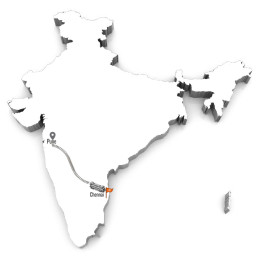
Jnana Yajna 2

Year & Dates:
April 25, 1953 to June 05, 1953

Yajna Topics:
Mundaka Upanishad

Place:
Arni Palace, Egmore, Chennai, India
What started with the blessings of Lord Ganesha and mesmerized the crowds in Pune was gathering momentum. The daring sage from the Himalayas could sense that the revival of Hinduism was afoot. But the path ahead was still full of challenges as Pujya Gurudev Swami Chinmayananda arrived in the rituals-focused southern city of Madras (now Chennai) to launch his second Jnana Yajna. A discouraged organizing committee, a prejudiced and unwilling public, and a lack of even a proper venue for the talks – nothing dampened the enthusiasm of the selfless Swami. The purity of His purpose prompted a most unlikely patron – a Muslim offered his place for the universal essence of Hinduism to ring out loud.
The Mission is Born!
On the evening of April 25, 1953, the first few listeners who sat in the spacious courtyard before Arni Palace in Egmore, inside the pandal (tent) with its flickering petromax lanterns, were entranced by the stately Swami Chinmayananda. They recall being overcome “by an awe-inspiring Presence of the Supreme.” By the end of that 41-day yajna, the pandal couldn’t contain the increasing crowds that stood captivated by Pujya Gurudev’s matchless discourses on Mundakopanishad.
The skeptical listeners in Chennai who were transformed into spirited seekers appealed to Swami Chinmayananda that summer of 1953. They wanted to form “Chinmaya Mission” as an organization to enable them to reflect and absorb the teachings after every Jnana Yajna. At first, Pujya Gurudev refused to be institutionalized. However when the group of devotees in Madras(Chennai) insisted that the word ‘Chinmaya’ referred to the Supreme, Pure Knowledge that they aspired to gain, He agreed to the name “Chinmaya Mission.” Thus, on August 8, 1953, was born Chinmaya Mission whose branches would soon encircle the world.
In Admiration
“Offering of all our negativities and animalism into the fire of Knowledge is what I meant by Jnana Yajna,” is how Pujya Gurudev Swami Chinmayananda described as he emphasized on deep Hindu ideas such as self-restraint and self-training through relentless sadhana during his 2nd Jnana Yajna. Shri R Gopalakrishnan, a devotee who attended his early Yajnas in Chennai recounts, “Sitting on His mattress of easy camaraderie, Swami Chinmayananda used to dissect our day-to-day life and religion with his double-edged sword of Reason and Logic. The “Lion of Vedanta” expounded the esoteric science of Advaitic Philosophy in a language at once mellifluous, sonorous and roaring. The highlight of his lectures is undoubtedly the telling effect of his homely smiles deftly employed to exhibit the same thought from several points of view. The congregational meditation at the conclusion of the daily lectures has captivated many!”
Photo Gallery

“Think,” says Pujya Gurudev!
The Upanishad-Seers, by a process of complete elimination of their ego, achieved through the divine method of sublimation, when they reached the Palace of Truth, they entered therein to rediscover themselves to be the owners of it. That Realm of Perfection is indeed the world which having reached no one returneth. However, there are some among them, rare birds, who had flown back, in their divinely selfless game of service, to lead, guide and encourage other manifestations of themselves, unto the same Truth. They try to express the topography of the Realms-Beyond and the main paths by which one may reach it.
At such moments of Godly inspiration and intoxicating bliss the Rishis forgot to subscribe their names to their own masterpieces, the Upanishads! Thus, we have an incomparable literature on philosophy in the volumes of the Upanishads, the authors of which are unknown to us. We only know that there was behind these sparkling words of wisdom a personality who reveled in the subjective experience of the very theme which they describe in such a wealth of details.
From Mundakopanishad, first edition June 1953 page 4-5
Insights from Mundakopanishad Talks in Pittsburgh (1984)
Discover the Upanishadic metaphor of the bow and arrow, where the Upanishad serves as the bow and the mind as the arrow. Learn the art of sharpening the mind through worship, prayer, and various yogas. Dive into the discourse on Ayamya Yoga, understanding the importance of turning the mind towards the divine reality. Explore the powerful analogy of the arrow hitting its target, symbolizing the dissolution of the self into the state of consciousness. Join Pujya Gurudev in unraveling the transformative wisdom of the Upanishadic teachings.
Jnana Yajna 1
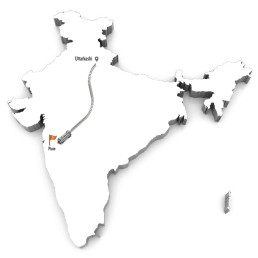
Jnana Yajna 1

Year & Dates:
December 31, 1951 to April 08, 1952

Yajna Topics:
Kenopanishad and Kathopanishad

Place:
Ganesha Temple, Rasta Peth, Pune, India.
True to His deep conviction that “Hinduism in its whole vigour and power is in the Upanishads,” Pujya Gurudev Swami Chinmayananda’s first Jnana Yajna was an extraordinary offering of Knowledge in its most strong, sublime form. His plan was bold – a 100-day Yajna where the Swami would expound on the exalted Truth declared in Kenopanishad and Kathopanishad. In spite of hesitation, lack of support, and even opposition from varied quarters, His painstaking, selfless efforts to give the Highest were like opening the floodgates of an ocean of Knowledge.
Vedantic Renaissance Begins
From an audience of only 18 on the first day of His Jnana Yajna on Dec.31, 1951, at the small Ganesha Temple in Rasta Peth, Pune, the crowds swelled to over a thousand to hear the glory of Hindu Scriptures explained in English and experience the power of Vedanta Shravanam. For a hundred days, the Yajna evoked the Highest; the unique format of the Jnana Yajna with daily Upanishadic discourses, Akanda Kirtan, bhajans, and clearly-explained homas conducted by priests uplifted an audience that had been motivated to also practice brahmacharya to absorb the essence of the Supreme Knowledge.
A tireless, fearless Sage had taken up the divine sankalpa of a Vedantic Renaissance.
There was no turning back – the Goal was glorious, and the Way was lit with Grace and great blessings of Mother Shruti and His Gurus.
In Admiration
Shri Madhukar Veeraswami Naidu of Chinchwad, Pune recalls how he was compelled to attend the discourses of the first Jnana Yajna. He had been a regular visitor to the Ganesha temple, solely interested in taking the prasad, which was distributed in the evening. He was much drawn towards this young swami there holding forth so eloquently on the scriptures. “My mission is to convert Hindus to Hinduism,” said Gurudev. These words still ring in Naidu’s ears. Here was a swami, a stranger to Pune, lived in Madras Dharamshala, dyeing ochre the cloth given to him by some devotees, speaking impeccable English, wearing a unique head-dress, and working with missionary zeal. All these traits appealed to the residents of Poona at that time.
Pujya Gurudev thus sounded the auspicious conch of the Chinmaya Movement on 31 December 1951 at Pune. A saffron flag with the mystic syllable ॐ inscribed on it was first hoisted there.
For the complete story of the first Jnana Yajna: Story Behind First Jnana Yajna; Jnana Yajna Part 1; Jnana Yajna Part 2
Photo Gallery

“Think,” Says Pujya Gurudev
“Though the Guru indicates to the burning aspirant that Truth is “that Life Centre which manifests as the power of sight in the eye, the power of hearing in the ear, the power of speech in the tongue etc.,” he is equally anxious to warn the disciple; “ the Absolute Truth is that power which is in no way associated with any of its seeming conditionings such as the ear, eye, mind, etc.”
From Kenopanishad Yajna Prasad Vol.4, p.130
Wonderful is he who comprehends: – What a rare percentage of the whole can in each generation come to live the voiceless joy of their life’s fulfillment. The chance to hear is rare; even when heard to digest and understand those subtle ideas is rarer; a Master, who is efficient enough to initiate a student into the Absolute and satisfying all his doubts, guide him into the Realms Beyond is rarer and, even when an individual comes to be lucky to enjoy the blessings of all the above three, Lord Death says, only the luckiest one comes to experience Godhood in this very birth while listening to the teacher discoursing upon the Sruti texts.
From Kathopanishad Yajna Prasad, Vol.1, Part 3 p.107
Chariot of Wisdom
Transport yourself back to the enchanting era of 1951-52 and experience the profound first yajna. Fast forward to 1982, where a later yajna on Kathopanishad unfolds, offering a chance to relive the wisdom and insights.
Explore the profound metaphor of the chariot in this excerpt from a Kathopanishad discourse by Swami Chinmayananda in Toronto, Canada in 1982. Delve into the relationship between the Lower and Higher Self, understanding the mind as the steering wheel controlled by intellect. Discover how sense organs serve as trotting horses, dragging the body through the muddy roads of sensuality. Unravel the analogy of Arjuna as the individual in the body, with Krishna as the pure intelligence guiding the chariot. Join the insightful journey of self-contemplation and learn to navigate the roads of life with a pure intellect.
Kaushalya's Leadership
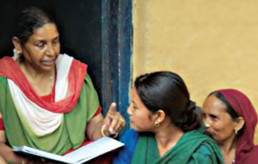
From Troubled Life to Role-Model
Kaushalya’s story is similar to Urmila’s but with a difference; her husband did not beat her. She had the support of a wonderful mother-in-law. However, her husband was drunk most of the time and did nothing to earn a living and support the big family. Kaushalya and her daughters worked as laborers in the agricultural fields of others and in their own little land and eked out a living to somehow have two meals a day.
Her eldest daughter, who is now married and well settled, recalls with tears in her eyes how, when she was sixteen years old, she wanted to go to school to study, but she had nothing suitable to wear. Her kameez (a long shirt that is worn over loose pants, the salwar) was torn, and she had already mended it several times. The kameez had ultimately torn beyond repair. She, however, had a woolen sweater which was fine. So she hid the torn part of the kameez uniform with the sweater and went to school all summer wearing the sweater! If anyone asked her whether she did not feel hot with the woolen sweater on, she would simply reply that she had a fever and felt cold! Thus, Kaushalya and her family lived in dire poverty when she joined CORD as a village health guide. Soon, like Urmila, she grew to be a team leader in the organization and a micro-entrepreneur at home. In 2000, she was elected as a member of the Zillah Parishad (District Council), which presided over the local self-governance of eleven Panchayats. She had hardly campaigned; however, she won the election by word of mouth of the villagers, who appreciated her sincere work.
While representing them at the district level, she successfully demanded response from local government to meet the needs of her constituency. Without hesitation, she trained many others, especially women, to become effective representatives of the people. For her comprehensive work on various issues, she too has been interviewed by news media several times, including the government’s All India Radio. In 2013, to CORD’s pride, Pujya Guruji Swami Tejomayananda felicitated Kaushalya as a ‘Karma Yogi’ in his inaugural address on ‘Karma Yog’ in New Delhi.
The essential advice that Kaushalya gives to new workers joining CORD is: “The key to work at the grassroots level is to build a lasting relationship with the villagers. Be a real friend in need who keeps his or her promises and delivers services on time.” Today, she helps CORD monitor, support, and build the Odisha and Punjab (Sidhbari satellite site) program, besides her many other responsibilities at Sidhbari. She was one of the main trainers who lived in Odisha for a few months to build and train the team of grassroots workers when CORD initiated the Program in Odisha.
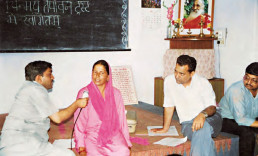
With the Guru’s Blessings
If Urmila Devi treasures the letter that she received from Gurudev and her photograph with him, Kaushalya Devi recalls how he appeared in her dream one night when she was emotionally down, and how the problem just evaporated the next morning! In February 1992, when Gurudev was recuperating from his illness at the Sidhbari ashram, Kaushalya stood in front of him with folded hands, inviting him to her eldest daughter’s wedding in Sidhbari. Gurudev looked at her kindly and said to her that he would not be able to come. He said, “I cannot sit down with you all nor can I eat oily food as my heart condition does not allow it.” He then inquired with care if she needed money for the wedding. Kaushalya at once said: “No, Gurudev, I only want your blessings.” To this, Gurudev replied: “Shaadi ki chinta mat karo, sab thik ho jayega” (Do not worry about the wedding; all will be well).
Kaushalya remembers this with gratefulness when she recalls how everything at the wedding went smoothly. Her husband and his alcoholic friends, whom she had expected to create noise and confusion, behaved well during the wedding; the limited food supply, which she thought would run out and embarrass her, was not only enough for all those who poured into her house from afternoon until night, but was enough left over for the family to consume the next morning! “The people still praise the tasty food that was served!” says Kaushalya with devotion and gratitude.
